
The Great Smoky Mountains are a mountain range rising along the Tennessee–North Carolina border in the southeastern United States. They are a subrange of the Appalachian Mountains, and form part of the Blue Ridge Physiographic Province. The range is sometimes called the Smoky Mountains and the name is commonly shortened to the Smokies. The Great Smokies are best known as the home of the Great Smoky Mountains National Park, which protects most of the range. The park was established in 1934, and, with over 11 million visits per year, it is the most visited national park in the United States.

Euxoa messoria, the darksided cutworm or reaper dart, is a moth of the family Noctuidae. The species was first described by Thaddeus William Harris in 1841. It is found from Newfoundland west to Yukon, south to Virginia and Missouri in the east and New Mexico, Arizona and California in the west.
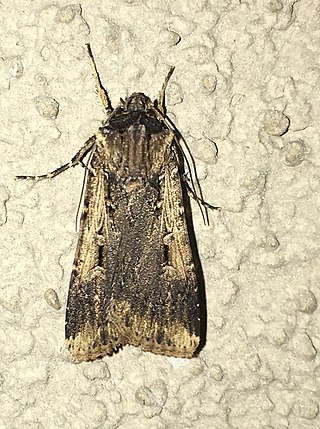
Agrotis volubilis, the voluble dart moth, is a moth of the family Noctuidae. The species was first described by Leon F. Harvey in 1874. It is found in North America, from Newfoundland to British Columbia in Canada and in the United States from Maine to Florida and west to the West Coast.
Euxoa campestris, the flat dart, is a moth of the family Noctuidae. The species was first described by Augustus Radcliffe Grote in 1875. It is found in North America from Newfoundland to Alaska, south to New England and southern Canada from southern Quebec west to British Columbia. In the west it is distributed southward in the Rocky Mountains to southern New Mexico, east-central Arizona, and central Utah. In the east it occurs in the Appalachians in eastern Kentucky and in western North Carolina.
Euxoa pleuritica, the fawn brown dart, is a moth of the family Noctuidae. It is found in southern Canada and the northern United States from southern Quebec and eastern Massachusetts west to British Columbia and southern Washington. In the Rocky Mountain region it occurs as far south as northern New Mexico, north-eastern Arizona and central Idaho. It is listed as a species of special concern in Connecticut.
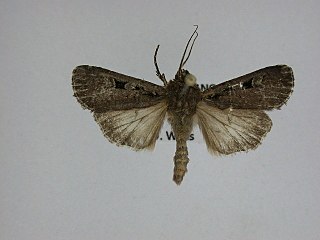
Euxoa tessellata, the tessellate dart or striped cutworm is a moth of the family Noctuidae. It is the most widespread Euxoa-species in North America. It is found from Newfoundland to Alaska, south in the west to California, Arizona, New Mexico, south in the east to Florida. It seems to be absent from Texas and adjacent eastern states.
Abagrotis magnicupida, the one-dotted dart, is a moth of the family Noctuidae. The species was first described by J. Donald Lafontaine in 1998. It is found from southern Massachusetts west to Illinois, eastern Missouri and central Nebraska, south to North Carolina, Tennessee, northern Mississippi and eastern Texas.

Eueretagrotis perattentus, the two-spot dart, is a moth of the family Noctuidae. It is found from coast to coast across central and southern Canada, and in the northern United States, south along the Appalachians to western North Carolina and Tennessee. There are a few scattered records along the Rocky Mountains from south-western Montana to south-eastern Arizona.
The sigmoid dart is a moth of the family Noctuidae. It is found in eastern North America species. In southern Canada it is found from Ontario to central Saskatchewan, and in the United States from Maine to Minnesota, south to western Maryland, Ohio, and western Kentucky. It has recently been recorded from North Carolina and Tennessee.
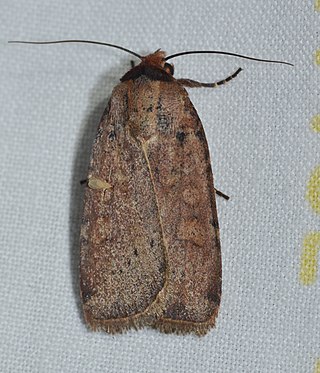
Protolampra brunneicollis, the brown-collared dart, is a moth of the family Noctuidae. The species was first described by Augustus Radcliffe Grote in 1864. It is found in eastern North America from New Brunswick to Alberta in southern Canada, and in the United States from Maine to North Carolina and Tennessee west to Mississippi, north to Minnesota, with scattered records in the west from North Dakota, South Dakota and Montana.
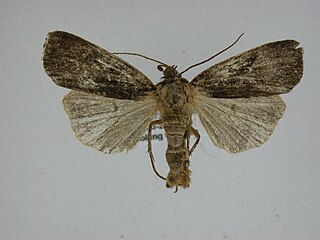
Pseudohermonassa bicarnea, the pink-spotted dart, is a moth of the family Noctuidae. The species was first described by Achille Guenée in 1852. It is found in eastern North America, and as far west as south-central Saskatchewan and central North Dakota, south to western North Carolina. It has recently been recorded from Tennessee.

Xestia dilucida, the dull reddish dart or reddish heath dart, is a moth of the family Noctuidae. The species was first described by Herbert Knowles Morrison in 1875. It is found in the United States from southern Maine to northern Florida, west to central Ohio and eastern Texas.
Xestia normaniana, or Norman's dart, is a moth of the family Noctuidae. The species was first described by Augustus Radcliffe Grote in 1874. It is found in North America from Nova Scotia across southern and central Canada to Alberta. In the eastern United States it ranges from Maine to eastern Minnesota, and south along the Appalachians to western North Carolina. It has recently been recorded from Tennessee.
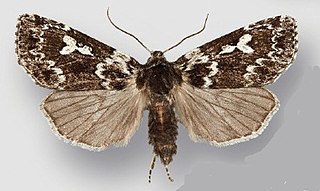
Xestia perquiritata, the boomerang dart, is a moth of the family Noctuidae. The species was first described by Herbert Knowles Morrison in 1874. It is found across North America from Newfoundland, Labrador and northern New England, west to central Yukon, British Columbia and Washington. There are several disjunct populations, including one in the Great Smoky Mountains National Park and the Rocky Mountains in Colorado and a coastal bog in central Oregon.

Xestia smithii, or Smith's dart, is a moth of the family Noctuidae. The species was first described by Pieter Cornelius Tobias Snellen in 1896. It is found across northern North America from Newfoundland to Alaska. In the eastern United States it occurs from Maine to Virginia and south along the Appalachians to North Carolina. In the west it is found in the Black Hills in western South Dakota and north-eastern Wyoming, in the Rocky Mountains from Montana to New Mexico, south-eastern Arizona, and from Washington to east central California. It has recently been recorded from Tennessee.
Abrostola ovalis, the oval abrostola, is a moth of the family Noctuidae. The species was first described by Achille Guenée in 1852. It is found in north-eastern North America from southern Quebec and Maine south to North Carolina and west to Wisconsin.

Diachrysia aereoides, the dark-spotted looper or lined copper looper, is a moth of the family Noctuidae. The species was first described by Augustus Radcliffe Grote in 1864. It is found in North America from Newfoundland west to northern California. It reaches its southernmost distribution in Great Smoky Mountains National Park.
Polychrysia morigera, the disjunct looper, is a moth of the family Noctuidae. The species was first described by Henry Edwards in 1886. In the east of North America, it is found in the Mississippi, Missouri, and Ohio river valleys from Pennsylvania to Tennessee. In the Rocky Mountains it is found from Montana to Colorado and on the west coast it occurs from Oregon to northern California. It is the rarest of the North American Plusiinae species.
Chrysanympha formosa, the Formosa looper, is a moth of the family Noctuidae. The species was first described by Augustus Radcliffe Grote in 1865. It is found in North America from Newfoundland west to Manitoba and south to the mountains of North Carolina and Tennessee.
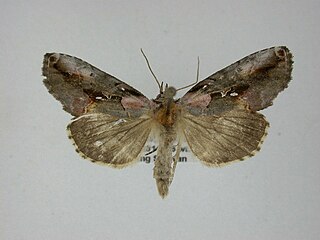
Eosphoropteryx thyatyroides, the pink-patched looper moth or pink-tinted beauty, is a moth of the family Noctuidae. The species was first described by Achille Guenée in 1852. In North America it is found from Nova Scotia and northern Ontario south to Minnesota, Michigan, Ohio and along the Appalachians from Maine to eastern Tennessee and western North Carolina; and to the west, it occurs from central Alberta and southern British Columbia, south in the Cascades to southern Oregon, and in the Rocky Mountains to northern Idaho.












